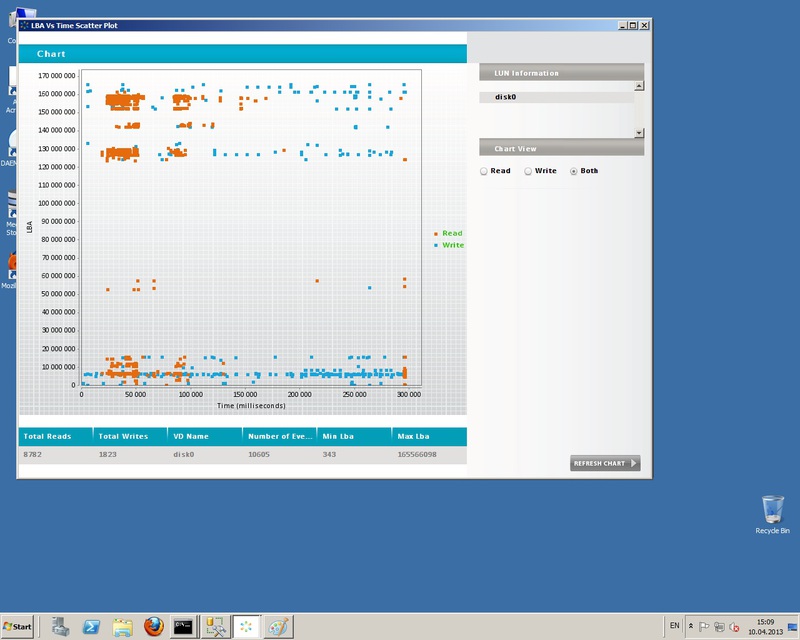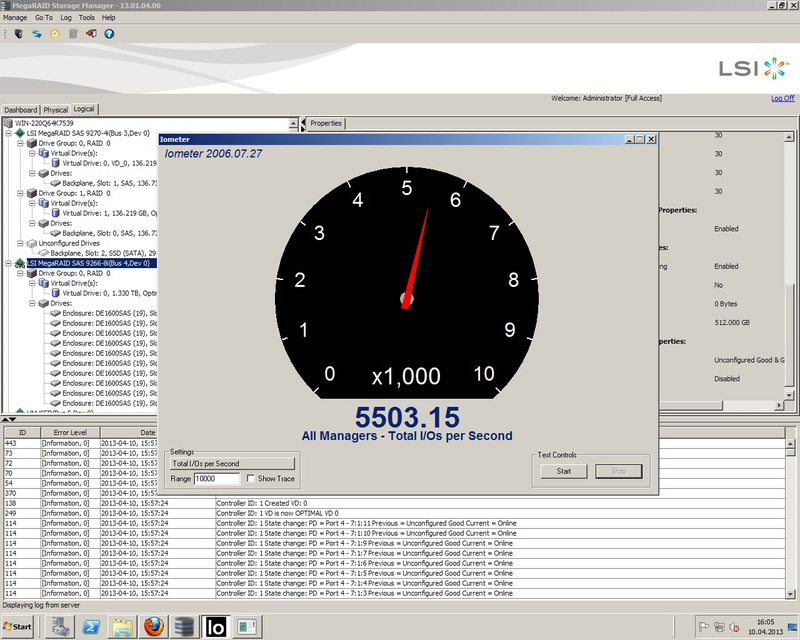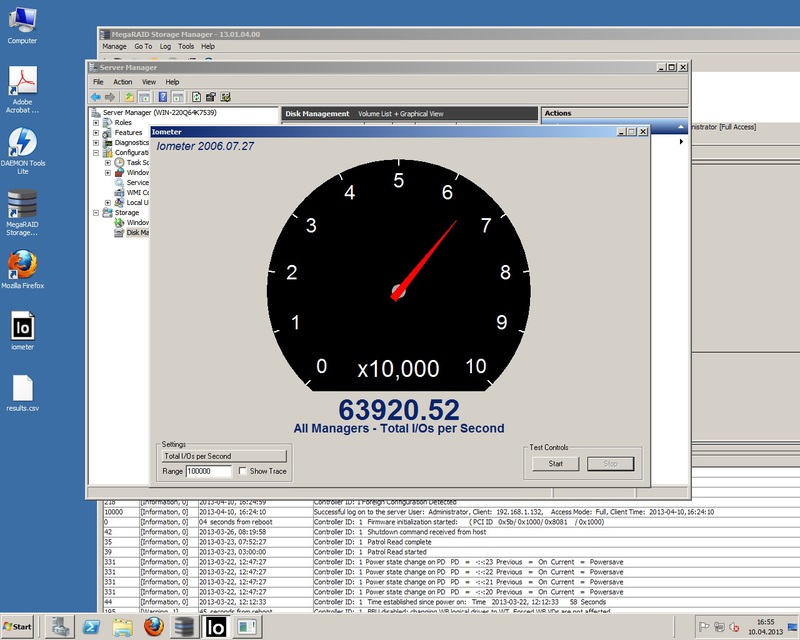LSI practice
Even the most avid skeptics already admit that SSD technologies have a number of undeniable advantages compared to conventional hard drives and allow you to get significantly higher I / O performance (and in some cases I / O speeds don't happen much). At the same time, SSDs are not yet ready for widespread deployment instead of traditional hard drives for a number of reasons: from price to reliability. What to do? Hybrid solutions that combine traditional drives with SSDs come to the rescue, allowing you to get (albeit with certain reservations) the advantages of both solutions.
If you don’t go into details, the very principle of operation of hybrid systems is quite simple (and if you go deeper, you can immerse yourself so much that you don’t return for a year) and are the same for all systems, starting with Seagate Momentus XT and Apple Fusion Drive discs, ending with expensive and complex solutions for large storage systems and data centers, which are discussed today.
For the main data storage, traditional hard drives are used, if necessary combined into a RAID, and the SSD is used to cache the most frequently used data that needs to be accessed most often. Managing the caching system takes over, and most often the cache partition in the system is generally not available as a separate disk.
')
In large and "serious" systems, I / O optimization issues are even more acute than for desktop computers. The fact that for the user is a second delay in the launch of a heavy program, in the case of a loaded server, can result in many thousands of dollars in losses if the disk subsystem becomes a bottleneck that slows down all the work.
Speaking of large storage systems, one can not forget about the company LSI, which, being one of the largest suppliers for storage systems, could not stand aside. The LSI product portfolio has a set of solutions for speeding up disk systems integrated into the Nytro family.
The line of these products is divided into three groups.
Nytro WarpDrive Application Acceleration Card
SSD disk made in the form of a PCI-express card, which can be installed in most modern servers, providing a high-speed disk for the system needs.
Nytro XD Application Acceleration Storage Solution
A complex of WarpDrive cards and specialized software that integrates into the system and uses an SSD for caching critical data. This approach allows you to speed up any block storage systems, regardless of the connection method (iSCSI, DAS, SAS, FC or any other). All you need to accelerate - block device.
Nytro MegaRAID Application Acceleration Card
These cards are essentially RAID controllers built on top-end LSI RAID-on-chip solutions, with the addition of high-speed NAND Flash. Special algorithms automatically determine the data to be cached, so this solution works independently of the operating system and is completely transparent to it.

In order to demonstrate in practice how to speed up the work with input / output, on April 11, LSI conducted a seminar or a workshop dedicated to this topic (details about this event are given below).
Since corporate IT requires a reasonable and balanced approach, you must make sure that it solves an existing problem before introducing any technology or solution. In order to help sort out this issue, LSI developed the Nytro Predictor program, which works with two main server operating systems - Windows and Linux. Predictor uses standard for each system statistics collection tools: xperf for Windows and blktrace for Linux, working in the background, is completely transparent for user tasks.
To understand Predictor, you need to work for some time in the background, collecting data while the computer performs typical tasks (it is better to give time with a margin). After that, you can get acquainted with the results of his work, and based on this, it is already up to you to decide what to do.
Now let's go back to the technical workshop and look at all this in practice.
For the experiments, a test bench of the following configuration was used:
SuperMicro Server on X8ST3-F, OS Windows 2008 Server R2
630J Storage System
Nytro MegaRAID 8110 (200 Gb)
Nytro XD BLP4-400 (400 Gb)
MegaRAID 9271-4i controller
9266-8i controller with CacheVault function and CVM01 unit
9286-8e controller
Predictor launch and load modeling. The typical load was the MSSQL query processing a lot of data.

We launched a profiler for data collection and then executed a query. If the profiler worked for a short time, the results will be of little use.

After collecting data during the server in its “typical” mode, we give it to the “predictor”. After analyzing them, he makes his verdict.

You can see in detail how read / write requests were distributed depending on the block size, and even into which sectors read / write went.


Here is a very telling example of how the Nytro Predictor works on a real SAN system. The graphs show very clearly how, as far as “warming up”, the cache optimizes the input-output.


Of course, the best results look at real tests. Here is an example used during the workshop. To begin, measure system performance on a RAID0 assembled from 10 Seagate Cheetah 146Gb 15K HDDs. JBOD LSI 620J. Controller: 9266-8i. Platform: SuperMicro X8ST3-F, OS Windows 2008 Server R2

Now, it stopped after connecting Nytro MegaRAID 8110, note that the results are more than an order of magnitude better.

Here is a simple example of how SSD works in large data storage systems. If you have any questions, I will be happy to answer them.
If you don’t go into details, the very principle of operation of hybrid systems is quite simple (and if you go deeper, you can immerse yourself so much that you don’t return for a year) and are the same for all systems, starting with Seagate Momentus XT and Apple Fusion Drive discs, ending with expensive and complex solutions for large storage systems and data centers, which are discussed today.
For the main data storage, traditional hard drives are used, if necessary combined into a RAID, and the SSD is used to cache the most frequently used data that needs to be accessed most often. Managing the caching system takes over, and most often the cache partition in the system is generally not available as a separate disk.
')
In large and "serious" systems, I / O optimization issues are even more acute than for desktop computers. The fact that for the user is a second delay in the launch of a heavy program, in the case of a loaded server, can result in many thousands of dollars in losses if the disk subsystem becomes a bottleneck that slows down all the work.
Speaking of large storage systems, one can not forget about the company LSI, which, being one of the largest suppliers for storage systems, could not stand aside. The LSI product portfolio has a set of solutions for speeding up disk systems integrated into the Nytro family.
The line of these products is divided into three groups.
Nytro WarpDrive Application Acceleration Card
SSD disk made in the form of a PCI-express card, which can be installed in most modern servers, providing a high-speed disk for the system needs.
Nytro XD Application Acceleration Storage Solution
A complex of WarpDrive cards and specialized software that integrates into the system and uses an SSD for caching critical data. This approach allows you to speed up any block storage systems, regardless of the connection method (iSCSI, DAS, SAS, FC or any other). All you need to accelerate - block device.
Nytro MegaRAID Application Acceleration Card
These cards are essentially RAID controllers built on top-end LSI RAID-on-chip solutions, with the addition of high-speed NAND Flash. Special algorithms automatically determine the data to be cached, so this solution works independently of the operating system and is completely transparent to it.

In order to demonstrate in practice how to speed up the work with input / output, on April 11, LSI conducted a seminar or a workshop dedicated to this topic (details about this event are given below).
Since corporate IT requires a reasonable and balanced approach, you must make sure that it solves an existing problem before introducing any technology or solution. In order to help sort out this issue, LSI developed the Nytro Predictor program, which works with two main server operating systems - Windows and Linux. Predictor uses standard for each system statistics collection tools: xperf for Windows and blktrace for Linux, working in the background, is completely transparent for user tasks.
To understand Predictor, you need to work for some time in the background, collecting data while the computer performs typical tasks (it is better to give time with a margin). After that, you can get acquainted with the results of his work, and based on this, it is already up to you to decide what to do.
Now let's go back to the technical workshop and look at all this in practice.
For the experiments, a test bench of the following configuration was used:
SuperMicro Server on X8ST3-F, OS Windows 2008 Server R2
630J Storage System
Nytro MegaRAID 8110 (200 Gb)
Nytro XD BLP4-400 (400 Gb)
MegaRAID 9271-4i controller
9266-8i controller with CacheVault function and CVM01 unit
9286-8e controller
Predictor launch and load modeling. The typical load was the MSSQL query processing a lot of data.

We launched a profiler for data collection and then executed a query. If the profiler worked for a short time, the results will be of little use.

After collecting data during the server in its “typical” mode, we give it to the “predictor”. After analyzing them, he makes his verdict.

You can see in detail how read / write requests were distributed depending on the block size, and even into which sectors read / write went.


Here is a very telling example of how the Nytro Predictor works on a real SAN system. The graphs show very clearly how, as far as “warming up”, the cache optimizes the input-output.


Of course, the best results look at real tests. Here is an example used during the workshop. To begin, measure system performance on a RAID0 assembled from 10 Seagate Cheetah 146Gb 15K HDDs. JBOD LSI 620J. Controller: 9266-8i. Platform: SuperMicro X8ST3-F, OS Windows 2008 Server R2

Now, it stopped after connecting Nytro MegaRAID 8110, note that the results are more than an order of magnitude better.

Here is a simple example of how SSD works in large data storage systems. If you have any questions, I will be happy to answer them.
Source: https://habr.com/ru/post/179671/
All Articles